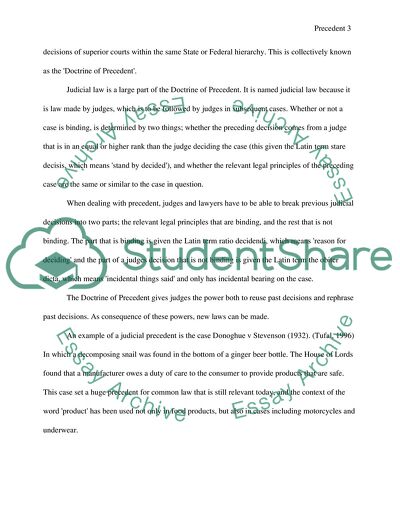
- Home
- Free Samples
- Premium Essays
- Editing Services
- Extra Tools
- Essay Writing Help
- About Us
- Studentshare
- Subjects
- Miscellaneous
- The doctrine of precedent can be considered both a blessing and a curse
The doctrine of precedent can be considered both a blessing and a curse - Essay Example

- Subject: Miscellaneous
- Type: Essay
- Level: Undergraduate
- Pages: 4 (1000 words)
- Downloads: 0
- Author: rosettacasper
Extract of sample "The doctrine of precedent can be considered both a blessing and a curse"
Local communities would congregate to form assemblies, also know as moots, where they would create laws based on common customary views shared among the community. At the beginning of the thirteenth century, the concept of common law began to emerge. An internal system of courts was set up, with each community sharing the same laws. Judges travelled to the communities and followed the same rules, therefore making the laws enforced throughout common to all. To provide consistency between the communities, if a judge was making a decision about a case, and there was a case of the same nature that had been decided by a judge before it, they would be resolved in the same way, with the same ruling.
That meant that the first judge to make a ruling on a particular case had made a law that judges in following cases (which were of the same nature) were obliged to follow. This still applies within the Australian legal system today. Courts are bound (within prescribed limits) by prior decisions of superior courts within the same State or Federal hierarchy. This is collectively known as the Doctrine of Precedent. Judicial law is a large part of the Doctrine of Precedent. It is named judicial law because it is law made by judges, which is to be followed by judges in subsequent cases.
Whether or not a case is binding, is determined by two things; whether the preceding decision comes from a judge that is in an equal or higher rank than the judge deciding the case (this given the Latin term stare decisis, which means stand by decided), and whether the relevant legal principles of the preceding case are the same or similar to the case in question. When dealing with precedent, judges and lawyers have to be able to break previous judicial decisions into two parts; the relevant legal principles that are binding, and the rest that is not binding.
The part that is binding is given the Latin term ratio decidendi, which means reason for deciding and the part of a judges decision that
...Download file to see next pages Read MoreCHECK THESE SAMPLES OF The doctrine of precedent can be considered both a blessing and a curse
Taoism Religion
The Work of Remix in the Age of Digital Reproduction
When and why did the Sinatra Doctrine replace the Brezhnev Doctrine in Soviet policy towards East-Central Europe
The Doctrine of Precedent
The Doctrine of Precedent can be considered both a Blessing and a Curse
The Foreign Policy of Barack Obama
Is Deterrence Still a Useful Concept
The Concepts of the Separate Legal Personality as an Underlying Rock in the UK Corporate Law

- TERMS & CONDITIONS
- PRIVACY POLICY
- COOKIES POLICY